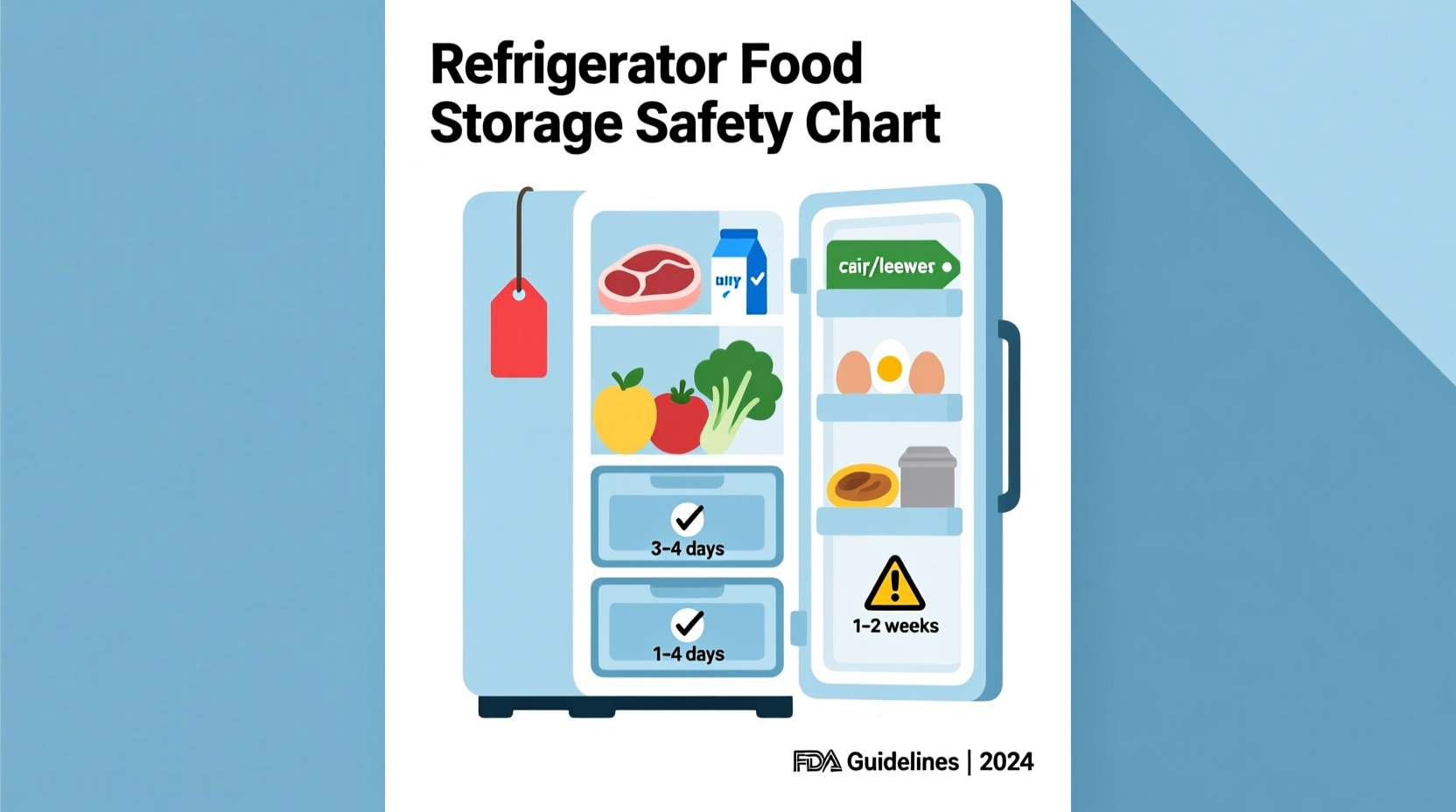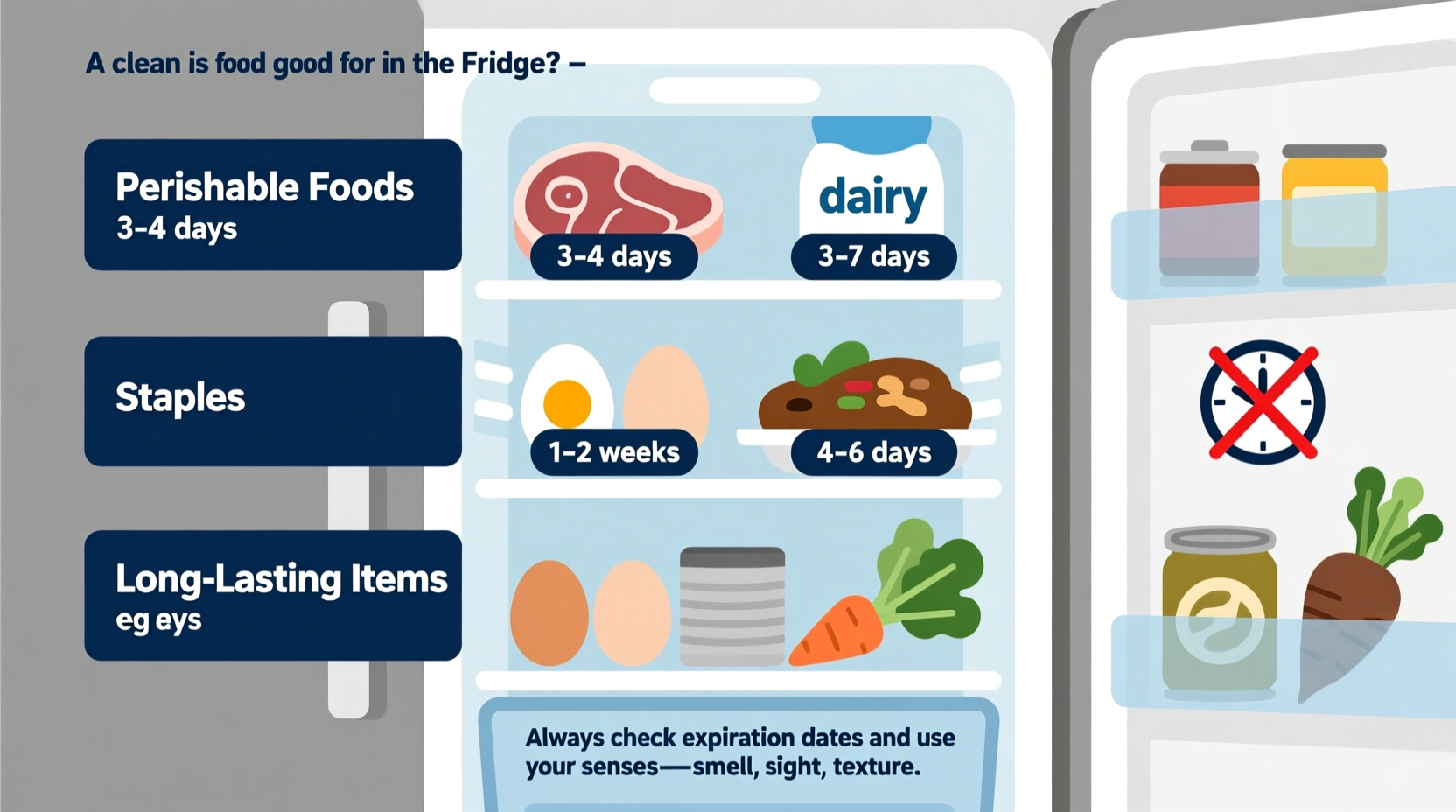Most leftovers stay safe for 3-4 days in the refrigerator at 40°F (4°C) or below. Raw poultry lasts 1-2 days, ground meats 1-2 days, steaks/roasts 3-5 days, eggs 3-5 weeks, and dairy products vary from 5-7 days (opened milk) to 1-2 months (unopened hard cheeses).
Wondering if that container of last night's dinner is still safe to eat? You're not alone. Each year, American households waste nearly $1,500 worth of edible food while simultaneously risking foodborne illness from improperly stored items. Understanding precise refrigerator shelf life isn't just about avoiding spoiled meals—it's a critical food safety practice that protects your health and your wallet.
Your Complete Guide to Refrigerator Food Safety
Food safety experts from the USDA and FDA consistently emphasize that proper refrigeration significantly reduces the risk of foodborne pathogens like Salmonella and E. coli. Yet confusion about "best by" dates and storage times leads to both unnecessary waste and dangerous consumption decisions. This guide cuts through the confusion with evidence-based timelines you can trust.
Food Safety Timeline: When Does Refrigerated Food Spoil?
Temperature control is your first line of defense. The USDA Food Safety and Inspection Service confirms that refrigerators should maintain 40°F (4°C) or below—the "danger zone" where bacteria multiply rapidly spans 40°F to 140°F (4°C to 60°C). But even at proper temperatures, different foods have varying shelf lives based on their composition.
| Food Category | Refrigerator Shelf Life | Critical Safety Notes |
|---|---|---|
| Raw poultry (chicken, turkey) | 1-2 days | Never store beyond 48 hours; cook within timeframe |
| Ground meats (beef, pork) | 1-2 days | Higher surface area increases spoilage risk |
| Steaks, roasts, chops | 3-5 days | Vacuum sealing extends by 2-3 days |
| Cooked leftovers | 3-4 days | Store in shallow containers for rapid cooling |
| Fresh eggs in shell | 3-5 weeks | Store in original carton away from door |
| Opened milk | 5-7 days | Smell test remains most reliable indicator |
| Hard cheeses (cheddar, swiss) | 3-4 weeks | Cut away moldy sections (1 inch around) |
| Leafy greens | 3-7 days | Wash only before use to prevent moisture buildup |
This comprehensive food safety timeline reflects current USDA FoodKeeper guidelines updated in 2024. The USDA Food Safety and Inspection Service maintains that these timeframes assume consistent refrigerator temperatures below 40°F (4°C) and proper storage practices.
Why Food Spoilage Timelines Vary: The Science Behind Shelf Life
Understanding why different foods have varying refrigerator lifespans helps you make informed decisions beyond rigid time limits. Three critical factors determine how quickly food spoils:
1. Water Activity and pH Levels
Foods with high moisture content (like cooked vegetables) spoil faster than drier items. Acidic foods (tomato sauce, citrus) resist bacterial growth longer than neutral pH foods. The FDA Food Code explains that water activity below 0.85 significantly slows pathogen growth.
2. Initial Contamination Levels
Raw meats naturally contain more bacteria than processed foods. The CDC's food handling guidelines note that proper cooking reduces but doesn't eliminate all bacteria—residual microorganisms continue multiplying during storage.
3. Temperature Fluctuations
Every refrigerator door opening raises internal temperature by 30-40°F for several minutes. University of Minnesota Extension research shows that inconsistent temperatures can reduce shelf life by up to 50%. This explains why items stored on the door (frequently exposed to warm air) spoil faster than those in main compartments.

Practical Food Storage Strategies That Extend Freshness
Professional kitchens follow specific protocols that home cooks can easily adopt. Implement these evidence-based techniques to maximize food safety and minimize waste:
Immediate Cooling Protocol
Divide large leftovers into shallow containers (2 inches deep or less) to cool food from 140°F to 70°F within 2 hours and to 40°F within 4 total hours. This rapid cooling process prevents dangerous bacterial multiplication during the cooling phase.
Strategic Placement System
- Bottom shelf: Raw meats (prevents cross-contamination from drips)
- Middle shelves: Dairy products and ready-to-eat foods
- Top shelf: Leftovers and prepared foods
- Crisper drawers: High humidity for leafy greens, low humidity for fruits
Labeling and Tracking Method
Use masking tape and marker to label containers with contents and date stored. The FDA recommends following the "first in, first out" principle—place newer items behind older ones to ensure timely consumption.
Recognizing Actual Spoilage vs. Normal Changes
Many foods undergo harmless appearance changes that get mistakenly discarded. Learn to distinguish between normal aging and actual spoilage:
Safe to Eat (With Proper Handling)
- Mold on hard cheeses (cut away 1-inch around affected area)
- Color changes in raw meats (grayish-brown from oxygen exposure)
- Crystallization in honey or maple syrup (removes texture but safe)
Immediately Discard
- Slippery film on meats or fish
- Sour or ammonia-like odors in dairy
- Mold on soft cheeses, yogurt, or lunch meats
- Bulging cans or packages (indicates dangerous gas production)
The USDA's "When in Doubt, Throw It Out" guideline remains the gold standard for food safety decisions. Trust your senses—when multiple indicators (sight, smell, texture) suggest spoilage, discard the item regardless of the calendar date.
Special Considerations for High-Risk Groups
While standard guidelines apply to most households, certain populations require stricter protocols. The CDC recommends reducing standard refrigerator storage times by 25-50% for households with:
- Immunocompromised individuals
- Pregnant women
- Children under 5
- Adults over 65
For these vulnerable groups, cooked leftovers should be consumed within 2 days rather than 3-4, and opened infant formula must be discarded after 24 hours regardless of printed expiration dates.
Reducing Food Waste Without Compromising Safety
Food safety and waste reduction aren't mutually exclusive goals. Implement these practical strategies:
Weekly "Fridge First" Meal Planning
Designate one weekly meal to use approaching-expiration items. Soups, stir-fries, and frittatas can creatively incorporate multiple ingredients nearing their shelf life limits.
Freezing as Strategic Extension
Properly frozen foods remain safe indefinitely (though quality degrades over time). The National Center for Home Food Preservation confirms that most cooked foods maintain quality for 2-6 months in the freezer when stored in airtight containers with minimal air exposure.
Temperature Monitoring System
Place an appliance thermometer in your refrigerator and check it weekly. The FDA Food Code requires commercial kitchens to monitor temperatures hourly—a simple weekly check at home prevents dangerous temperature creep that shortens shelf life.
Food Safety Beyond the Refrigerator
Remember that refrigerator storage is just one component of food safety. Always follow these complementary practices:
- Wash hands thoroughly before handling food
- Use separate cutting boards for raw meats and produce
- Cook foods to proper internal temperatures (165°F for poultry, 145°F for whole cuts of beef)
- Clean refrigerator shelves monthly with food-safe disinfectant
Frequently Asked Questions
How long can cooked chicken stay in the refrigerator?
Cooked chicken remains safe for 3-4 days when stored at 40°F or below in airtight containers. For maximum safety, consume within 72 hours, especially if the chicken was previously frozen. Always reheat to 165°F internal temperature before eating.
Is it safe to eat leftovers after 5 days in the refrigerator?
The USDA Food Safety and Inspection Service recommends discarding cooked leftovers after 4 days. While some foods might appear fine beyond this timeframe, pathogenic bacteria can multiply to dangerous levels without visible signs. When in doubt, throw it out—especially for high-risk groups.
Do "best by" dates indicate food safety?
No, "best by" dates refer to peak quality, not safety. The FDA explains that these are manufacturer estimates of when food will taste best. Many foods remain safe well beyond these dates when properly stored. Always use sensory evaluation (smell, appearance, texture) alongside date labels to determine safety.
Can I extend refrigerator shelf life by freezing foods?
Yes, freezing stops bacterial growth completely. The National Center for Home Food Preservation confirms that properly frozen foods remain safe indefinitely, though quality gradually declines. Most cooked foods maintain good quality for 2-6 months in the freezer. Always use airtight packaging and label with contents and date.
Why does food spoil faster in the refrigerator door?
Refrigerator doors experience significant temperature fluctuations—up to 40°F changes—each time they're opened. University of Minnesota Extension research shows these fluctuations can reduce shelf life by 30-50% compared to main compartments. Store condiments and less perishable items in the door, but keep dairy, meats, and leftovers on interior shelves where temperatures remain more stable.











 浙公网安备
33010002000092号
浙公网安备
33010002000092号 浙B2-20120091-4
浙B2-20120091-4